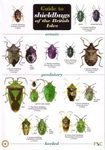![Ferrantia, Volume 4: Hétéroptères du Grand-Duché de Luxembourg: 1. Psallus (Hylopsallus) pseudoplatani n. sp. (Miridae, Phylinae) et espèces apparentées / 2. Quelques Espèces Peu Connues, Rares ou Inattendues Ferrantia, Volume 4: Hétéroptères du Grand-Duché de Luxembourg: 1. Psallus (Hylopsallus) pseudoplatani n. sp. (Miridae, Phylinae) et espèces apparentées / 2. Quelques Espèces Peu Connues, Rares ou Inattendues]()
Click to have a closer look
About this book
Customer reviews
Related titles
About this book
Language: French, with trilingual abstract in English, French and German
Heteroptères du Grand-Duché de Luxembourg contains two contributions:
1. Psallus (Hylopsallus) pseudoplatani n. sp. (Miridae, Phylinae) and Allied Species.
A. The study of the subgenus Hylopsallus E. Wagner, 1952 (belonging to the genus Psallus Fieber, 1858) in Luxembourg has revealed:
1. Six species exist in this country, one of which is a new one: Psallus (Hylopsallus) pseudoplatani n. sp., in addition to P. (H.) assimilis Stichel, 1956, P. (H.) variabilis (Fallén, 1829), P. (H.) perrisi (Mulsant, 1852), P. (H.) wagneri Ossiannilsson, 1953 and P. (H.) quercus (Kirschbaum, 1856) (the latter now transferred to the genus Asthenarius Kerzhner, 1962).
2. Coloration of the femora (fig. I): a) perrisi and wagneri: black, with a pale apex; b) variabilis and quercus: basal part black, apical part dark red with black spots; c) assimilis and pseudoplatani, males: dark (to blackish) with brownish yellow apical part with black spots; females: brownish (sometimes reddish) yellow, (a little) darker towards the base, with black spots on the whole length; usually red spotted near the knee in both sexes.
3. Morphology of the aedeagus (fig. 2 and 3, scanning electron microscope): a) perrisi and wagneri: there is no third lateral process, as stated by some authors who misinterpreted a furrow near the base of the distal process; b) assimilis: the proximal process is obliquely truncate at the top, with a denticle at the short side.
B. P. (H.) pseudoplatani n. sp. - Coloration similar to that of assimilis (fig. 4), aedeagus ressembling to that of variabilis (fig. 2), but the distal process is short, scarcely reaching the denticulate torus, which is more orderly arched and has more numerous ( >30) denticles placed in parallel ranges. - Host plant: Acer pseudoplatanus L. Adults from early June to early July.
C. Regional (maps) and general distribution of the six species.
2. Some little known, rare or unexpected species
35 interesting species (Miridae: 23, Anthocoridae: 4, Lygaeidae: 5, Acanthosomatidae: 1, Pentatomidae: 2) are reported. Twelve of them are confined to conifers, 9 to foliaceous trees, 9 to grassland or swamps, 5 to dry biotopes. Localities and dates of their discovery are given. The most interesting – Phytocoris meridionalis, Xylocoridea brevipennis, Orsillus depressus and Drymus pumilio – are illustrated. Short informations about the other (19) species found on conifers, about all species of Phytocoris found in the country, about species found together with Horvathiolus and with Drymus pumilio
Description of a new form: Trigonotylus coelestialium forma rubrovittata, f. n., with red or orange stripes on the ventral side. Illustrated details on the aedeagus of some Phytocoris and Psallus.
Customer Reviews
















![Ferrantia, Volume 78: Verbreitungsatlas der Reptilien des Großherzogtums Luxemburg [Distribution Atlas of the Reptiles of the Grand Duchy of Luxembourg]](http://mediacdn.nhbs.com/jackets/jackets_resizer_medium/24/242444.jpg?height=150&width=106)
![Ferrantia, Volume 73: Beiträge zur Paläontologie des Unterdevons Luxemburgs, Volume 4 [Contribution to the Palaeontology of the Lower Devonian of Luxembourg, Volume 4]](http://mediacdn.nhbs.com/jackets/jackets_resizer_medium/23/231481.jpg?height=150&width=106)
![Ferrantia, Volume 68: Beiträge zur Paläontologie des Unterdevons Luxemburgs, Volume 3 [Contribution to the Palaeontology of the Lower Devonian of Luxembourg, Volume 3]](http://mediacdn.nhbs.com/jackets/jackets_resizer_medium/21/215099.jpg?height=150&width=106)
![Ferrantia, Volume 63: La Flore Calcicole et Basophile du Massif Vosgien [The Calcicole and Basophile Flora of the Vosges Massif]](http://mediacdn.nhbs.com/jackets/jackets_resizer_medium/21/215136.jpg?height=150&width=106)
![Ferrantia, Volume 25: Atlas des Ptéridophytes des Régions Lorraines et Vosgiennes, avec les Territoire Adjacents [Atlas of the Pteridophytes of the Lorraine and Vosges Regions, with Adjacent Territories]](http://mediacdn.nhbs.com/jackets/jackets_resizer_medium/21/215223.jpg?height=150&width=104)


![Ferrantia, Volume 40: Les Macrolichens de Belgique, du Luxembourg et du Nord de la France: Clés de Détermination [The Macro Lichens of Belgium, Luxembourg and the North of France: Identification Keys]](http://mediacdn.nhbs.com/jackets/jackets_resizer_medium/21/215208.jpg?height=150&width=106)
![Ferrantia, Volume 75: Verbreitungsatlas der Amphibien des Großherzogtums Luxemburg [Distribution Atlas of the Amphibians of the Grand Duchy of Luxembourg]](http://mediacdn.nhbs.com/jackets/jackets_resizer_medium/23/233252.jpg?height=150&width=106)
![Ferrantia, Volume 61: Verbreitung der Zikaden des Großherzogtums Luxemburg: Atlasband [Distribution of Cicads in the Grand Duchy of Luxembourg: Atlas Volume]](http://mediacdn.nhbs.com/jackets/jackets_resizer_medium/21/215141.jpg?height=150&width=106)
![Ferrantia, Volume 47: Verbreitungsatlas der Libellen des Großherzogtums Luxemburg [Distribution Atlas of the Dragonflies of the Grand Duchy of Luxembourg]](http://mediacdn.nhbs.com/jackets/jackets_resizer_medium/21/215197.jpg?height=150&width=106)
![Ferrantia, Volume 33: Die Fledermäuse Luxemburgs (Mammalia: Chiroptera) [The Bats of Luxembourg]](http://mediacdn.nhbs.com/jackets/jackets_resizer_medium/21/215215.jpg?height=150&width=106)










![Hémiptères de France, de Belgique, du Luxembourg et de Suisse [Hemiptera of France, Belgium, Luxembourg and Switzerland]](http://mediacdn.nhbs.com/jackets/jackets_resizer_medium/22/226274.jpg?height=150&width=106)
![Tentōmushi: Getcho Sensei no Tentoumushikorekushon [Ladybirds: Mr. Getcho's Ladybird Collection]](http://mediacdn.nhbs.com/jackets/jackets_resizer_medium/26/264269.jpg?height=150&width=108)


![Ferrantia, Volume 57: Die Waldgesellschaften Luxemburgs: Vegetation, Standort, Vorkommen und Gefährdung [The Wood Plant Communities of Luxembourg: Vegetation, Location, Occurrence and Endangerment]](http://mediacdn.nhbs.com/jackets/jackets_resizer_medium/21/215152.jpg?height=150&width=106)
![Ferrantia, Volume 70: Verbreitungsatlas der Weberknechte des Großherzogtums Luxemburg [Distribution Atlas of the Harvestmen of the Grand Duchy of Luxembourg]](http://mediacdn.nhbs.com/jackets/jackets_resizer_medium/21/214555.jpg?height=150&width=106)

![Ferrantia, Volume 39: Verbreitungsatlas der Heuschrecken des Großherzogtums Luxemburg [Distribution Atlas of the Locusts of the Grand Duchy of Luxembourg]](http://mediacdn.nhbs.com/jackets/jackets_resizer_medium/21/215209.jpg?height=150&width=105)